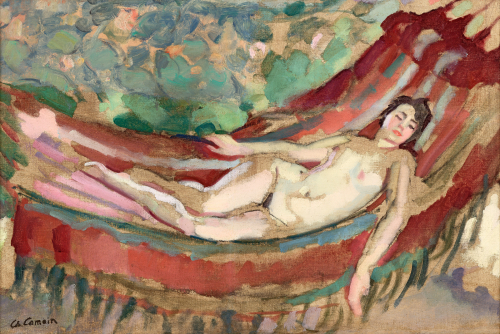Joan Miro was born in Barcelona in 1893 to parents who were creative craftsmen, jewelers and cabinetmakers. An illness at the age of 18 forced him to stay in the countryside of Mont-Roig, where he developed his creative instincts and decided, to the detriment of family advice, to take up painting.
After leaving business school, he entered Barcelona's Beaux-arts in 1907, taking classes with Modest Urgell and Josep Pasco, from whom he drew lessons in simplifying expression. Four years later, he continued his studies at the Galli Academy until its closure.
There he met Joan Prats, Josep Francesc Rafols Enric Cristófol Ricart, and Josep Llorens Artigas, with whom he founded L'agupacio Courbet, in reaction to emerging modernism. The group lasted until 1919.
In 1919, Miro moved to Paris, where he discovered cubism, fauvism and post-impressionism. He became close friends with André Masson and Max Jacob. All three lived together on rue Blomet, not far from the group of Jacques Prévert, Yves Tanguy and Marcel Duhamel. This emulation gave Miro a deep sense of having found himself. And it was during these years, in 1920, that he painted La Ferme, the masterpiece of his détailliste period.
Enchanted by the dreamlike and the unconscious, Joan Miro befriended André Breton, Louis Aragon and Paul Eluard, signing the Surrealist Manifesto with them. His paintings became increasingly schematic and geometric. With his friends, he wanted to create a new, more synthetic language. In 1924, he painted Paysages Catalans.
In 1925, Miro exhibited Carnaval d'Arlequin, a landmark work of his Surrealist period, at the Galerie Pierre, during the exhibition La peinture surréaliste, in Paris, alongside works by Paul Klee, Pablo Picasso and Max Ernst.
His works reflect his commitment to free expression. Biomorphic motifs intrude into these canvases.
In 1929, he married Pilar Juncosa and distanced himself from the Surrealists. His interest shifted to poetry, which was his primary interest in the Surrealists, before the group became too politicized for his taste.
He travels to Belgium and the United Kingdom and executes a series on "Dutch interiors".
The summer before the outbreak of war, Miro rents a house in Varangeville-sur-Mer. The summer of 1939 saw the birth of Les constellations, a major work comprising 22 gouaches on paper, which would serve as a central point of reference for his future productions. In this Normandy town, he also met Georges Braque and Raymond Queneau.
As the Germans bombed Normandy, Miro and his wife, along with their daughter, moved back to Spain, to Palma de Majorca. It was a time of transformation in the painter's life, as he began scribbling ideas for sculptures, lithographs, etchings and ceramics in his notebooks. At the end of that year, MoMA devotes a retrospective to Miro's work.
Four years later, with his childhood friend Josep Artigas, he produced his first ceramics. These, along with his previously unseen Constellations, were presented at the Galerie Pierre Matisse in 1945.
The two artists, in full creative swing, created Mur du Soleil and Mur de la Lune, two large-scale murals, which were inaugurated in 1958, for the Unesco headquarters.
Another mural was commissioned by Bauhaus founder Walter Gropius for Harvard University.
Miro confided that his figures, like his shapes and colors, needed to be purified, as he wanted to do a lot with a little. He continued his reflections. In 1960, Miro painted three canvases, Bleu I, II and III, which would become the artist's best-known works. A trip to Japan in 1966 reinforced this idea of purification and spontaneous balance. Woodcuts attest to this commitment.
In the last years of his life, Joan Miro was offered ever larger commissions and new ways of creating, such as stained glass, which he experimented with at a later date, and with the help of master glass artist Charles Marcq.
In 1975, the Joan Miro Foundation was inaugurated in Barcelona. The internationally acclaimed artist died on December 25, 1983 in his native Spain.

BRAFA 2023
28 January 2023 - 5 February 2023
